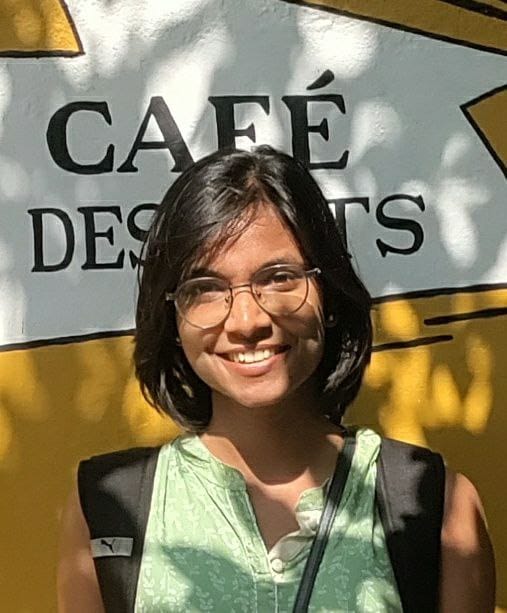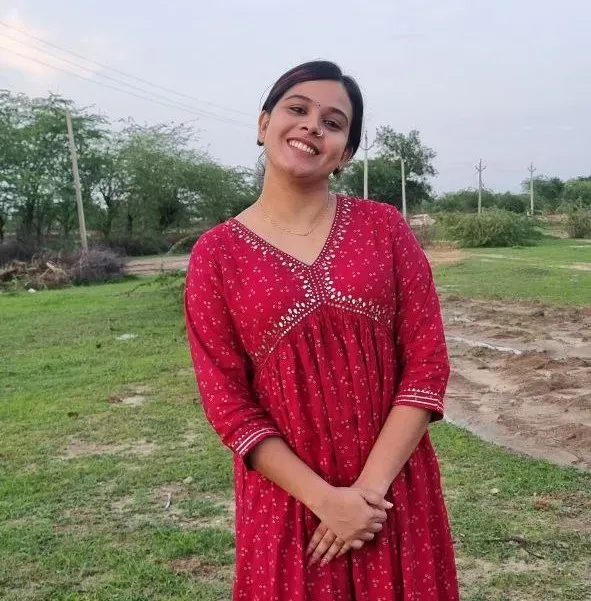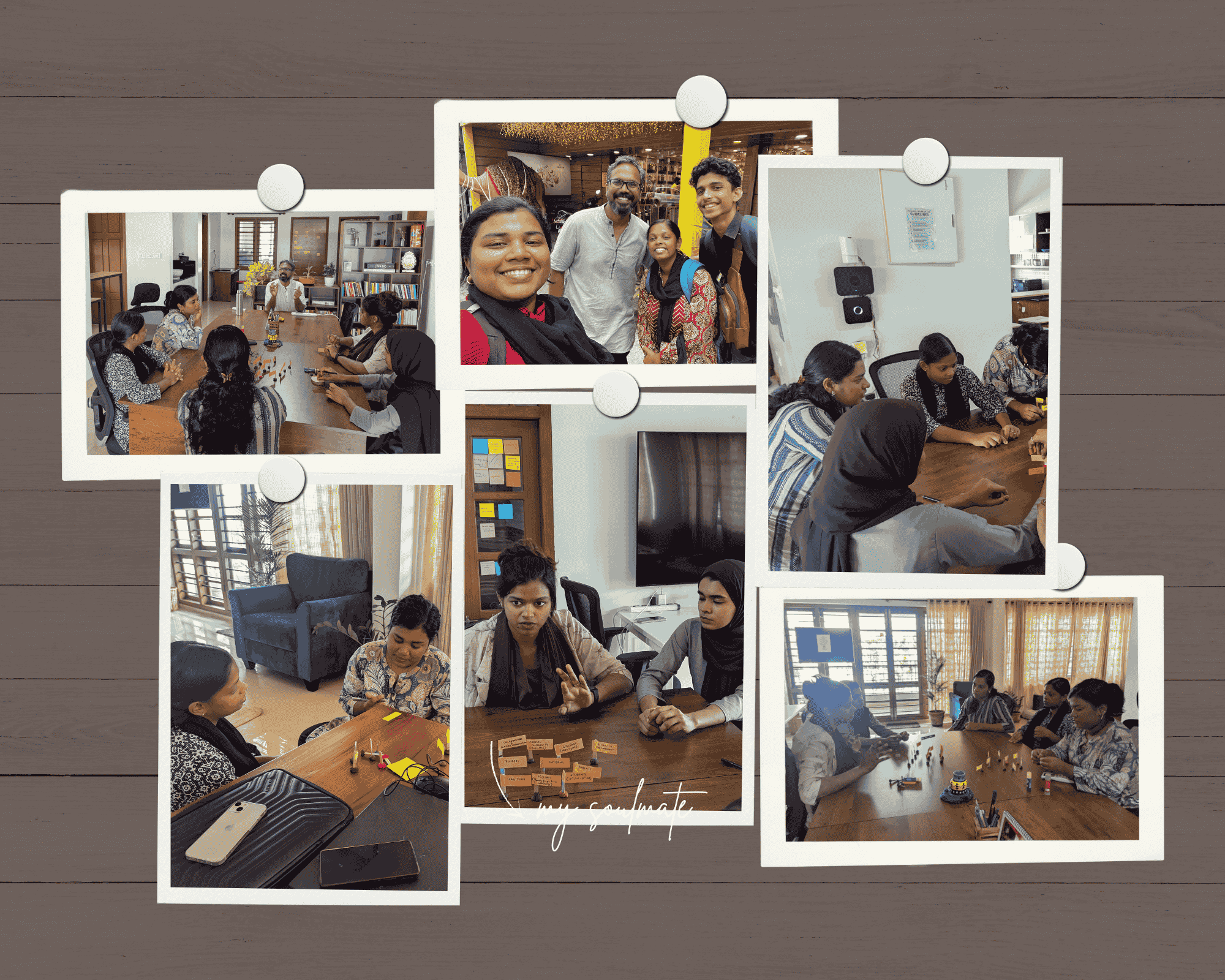Hridya Jairam and I sit on separate floor cushions in a room at aikyam space, and I notice that she exudes a warmth that instantly puts me at ease. She commands confidence with no laboured effort. The air of confidence soon makes sense as she talks about her family which consists of a women-only trio spanning three generations.
Living with an exceptionally strong-willed grandmother and mother, Hridya grew up amid political conversations and opinions. “I was in class 8 when I first accompanied Amma on one of her monthly orphanage visits. They were seeking an English tutor. That led to my first volunteering experience,” says Hridya. Despite such a background, 16-year-old Hridya had wildly different career plans. Enamoured by share trading and the capital markets, she had her eyes set on working for Goldman Sachs. Soon after graduation in 2016, Hridya moved to Bengaluru as an intern at her dream company.
What awaited her was a realisation that turned her life upside down, in all the right ways. Young Hridya saw right through the enticing facade of the drudgery in the Silicon Valley of India. She was increasingly disillusioned with working in what she calls “one among a thousand replaceable positions.” In two months, she took a leap considered rather risky for a professional in her early 20s. She turned in her resignation and returned to her home in Kerala. A couple of volunteering endeavours and 2 years later, she packed her bags and shifted to a remote village in Rajasthan. A friend had told her that an NGO in Kotri village, Manthan Sanstha Kotri, was looking for teachers.
“The populace of Kotri is mostly composed of farmers, goatherds, and workers in salt fields. Most of the children are married, and the literacy rate is alarmingly low. The nearest market is 15 km away,” says Hridya. “The first thing I did was to organise a session on goat-rearing; and guess what, the session that I had prepared meticulously for was graced by neither goatherds nor lost goats. Paradoxically, I was the learner that day. What would I, a city-bred person, teach the villagers, who have been rearing goats all their lives?”
Hridya decided to take the path less travelled. She set out to the town and returned with Simba, her trusted four-legged companion throughout her remaining stay in Kotri. The arrival of Simba, the goat, made Hridya a topic of conversation among the villagers. The girl from a faraway city had decided to live like them.
Herding goats to building community
Slowly, they began conversing with her about the increasing price of fodder (dried leaves of the khejri tree), goat health, and the pregnancy timelines of their herd. “Guruji, the man behind Manthan, once told me, ‘The villagers of Kotri know 99 out of 100 things about goats. The one thing they don’t and you do is to write ‘goat’ or ‘bakri’ on a piece of paper. And armed with this thought, we attempt to tutor them.’ I realised that an entire gulf separates literacy and education,” says Hridya.
Manthan has been running regular schools and night schools in Kotri since 1998. The schools act as bridges to prepare the students for the examination that decides their admission into a government school. Hridya taught in the regular schools and improved the curriculum and reduced dropout rates in the night schools. Not many turned up, but it was an extraordinary feat in itself to have a bunch of young girls, most of whom were married, in a classroom - and in case of night schools - after a day of work.
However, one Herculean problem persisted: language. “They spoke Marwadi, and I knew not a word of Hindi, let alone Marwadi,” says Hridya. “But we worked through it. I would show them a picture of an apple or point at a goat and utter the name in English. They would, in turn, tell me the Marwadi or Hindi word. With time, we picked up each other’s languages.” Her perseverance is rivalled only by the nonchalance with which she recounts her tales, laughing in that carefree way and absentmindedly stroking her streaks of red hair.
The girls and the sea
Hridya's teaching endeavour is strung together by intriguing classroom interactions. Once, she was naming the five oceans in a geography class when a girl stood up and asked, “What does an ocean look like?” Everything our young teacher had prepared for the day fell apart like a house of cards. Quickly gathering herself, she showed them pictures of the intriguing mass of water that forever refuses to be sighted in Rajasthan and said, “We will go to my home in Kerala, it is close to the sea.”
What followed was almost a year of determined effort to convince the parents of her 10 students to let her show them the sea. Hridya started by making daily appearances at the local tea stall and connecting with the villagers on a personal level. She shifted classes to the houses of her students and ensured that their parents could see the teacher-student dynamic for themselves. Little by little, the parents warmed up to Hridya and her daunting idea. Finally, on the 30th of September, 2019, 10 girls, who had never known a world outside their village, travelled almost 2,000km and felt the waves steal the sand from under their feet on a beach in Kerala.
Whenever she found the time, Hridya taught herself to write proposals for fundraising and create visibility for the organisation. From being a teacher to a program manager, she learned the ropes of social impact work. “What most social sector organisations do is study something that they perceive as a problem, formulate a solution in their closed rooms, and force-feed it to the rural population. Kotri taught me that there is no point in initiating a program in any community without connecting with them intimately and understanding their needs. After all, the programs are for them, not our inflated egos. Rural populations are not awaiting the filmy arrival of a messiah from the city,” she says, with a smile.

The birth of CSII
After the pandemic, Hridya worked as a program manager at Project DEFY and coordinated the Chief Minister’s Youth Centre Program under the aegis of the Meghalaya government. Working with a team of over 100 professionals, she spearheaded the opening of 22 centres of alternative education in the state. Although she was away from Rajasthan for quite some time, the sandy state had settled in her much like the thin layer of dust peppered on its trees throughout the year. In October 2023, she returned to Rajasthan, this time as the CEO and Co-Founder of the Center for Social Innovation and Impact (CSII).
CSII was birthed when three people - Hridya, Manasguru B, and Mina Jaleel - stumbled upon each other. Their concern was the same - there had to be a social impact organisation free from the self-imposed moral superiority of most similar endeavours. The false equating of such spaces with charity, the inclination towards considering it less of a job and more of a moral obligation, and the attempt to increasingly romanticise social commitment irked them tremendously. Hridya describes her practical approach to social impact: “What we do is neither charity nor kindness. We are merely facilitating the rights of a community and can claim no moral high ground. Social impact work is as much a job as any other where we require the space for individual growth and development. I am not as eager to scale CSII as I am to ensure that we adhere to our values, no matter how small our work is.”
The inception of CSII’s first project is a reflection of their overall modus operandi. Firstly, the team sat down for a conversation with the women in the Kalbeliya community in Bhervai. Concerns were heard, discussed, and understood.
“We are unable to travel anywhere as we cannot navigate.”
“We are mocked for having to resort to fingerprinting.”
“We cannot count money.”
The solution was brought to the table by the women themselves: they had to be aided in picking up a pen and paper. Next, CSII orchestrated a 3-day workshop during which the women decided they wanted a night school. CSII co-designed the program with the community; they facilitated an ecosystem and resources for the women to implement their ideas. Through theatre activities and mock setups of government offices, the students, who range from 16 to 75 years of age, have now learned a variety of life skills. Recently, the school organised an election modelled on the general elections and elected a Village Education Committee or Mahila Parliament that makes decisions for the school.
CSII's night school project in Rajasthan
CSII measures impact not through graphs or by checking off points designed by themselves, but via fulfilling the stakeholders' expectations. Hridya’s favourite marker of impact is the attendance register of CSII’s meetings with the Mahila Parliament. In the first meeting, the women marked their attendance with fingerprints. A few months later, some of the smudged ink marks on the paper were replaced with signatures; now, all the fingerprints have been knocked off the register!
Hridya says, “Recently, our students shared their experiences. They said, ‘We can now sign instead of stamping fingerprints, help our children with studies, and count money. We learned about banking, health, and the working of the panchayat.’ A student shared that she was able to travel to Jaipur boldly as she could read place names and boards.” Her eyes glint with pride as she quotes the students.
What marks the end of an academic year at CSII’s night schools is decided by each student. Some require assessments and certificates while others conceive business ideas for which CSII provides the initial resources. Aspiring tailors are provided with sewing machines and vegetable sellers, with shops.
The organisation engages in two categories: social innovation and research. The former is concerned with inclusive social action projects that are specifically suited to vulnerable communities. Currently, in their women’s night school project, CSII is successfully striking a balance between theatre of the oppressed and social impact; using art as a means of social innovation for the under-served.
“At CSII, we are greatly interested in gender-focused innovation. We find it unsettling that most projects and even products are designed for perfectly abled males. The cause is not a lack of resources, but a lack of thought in favour of accessibility. However, positing a problem in this aspect requires us to present data that support our claims. In the absence of data, our concerns will garner little more attention than empty rhetoric. That brings us to our second focal point: research. At CSII, we seek to augment research to establish the necessity of solving numerous social issues. Furthermore, existing research is far from accessible to the concerned communities. We intend to translate research into local languages or visual media that will enable them to understand the studies on them.”
As we arrive at the end of our conversation, I ask, “In the beginning, wasn’t it difficult to be so far away from everything familiar at such a young age? Especially while navigating without a strict institutional framework.” She smiles and replies, “Every time I was overwhelmed, I looked up at the clouds. In fact, I still do. I look up at them and name them: cumulonimbus, stratocumulus, stratus. So, even when nothing was familiar, I had clouds, and in Kotri, I had Simba.”
Hridya Jairam is the CEO and Co-Founder of the Center for Social Innovation and Impact, an NGO that facilitates education for women in Rajasthan’s Bhervai. Recently, she won the prestigious Chevening Scholarship for an MSc. in Social Innovation & Entrepreneurship at The London School of Economics and Politics. CSII has created tangible impacts in a short time and breathes hope for a better future for women in rural India.





